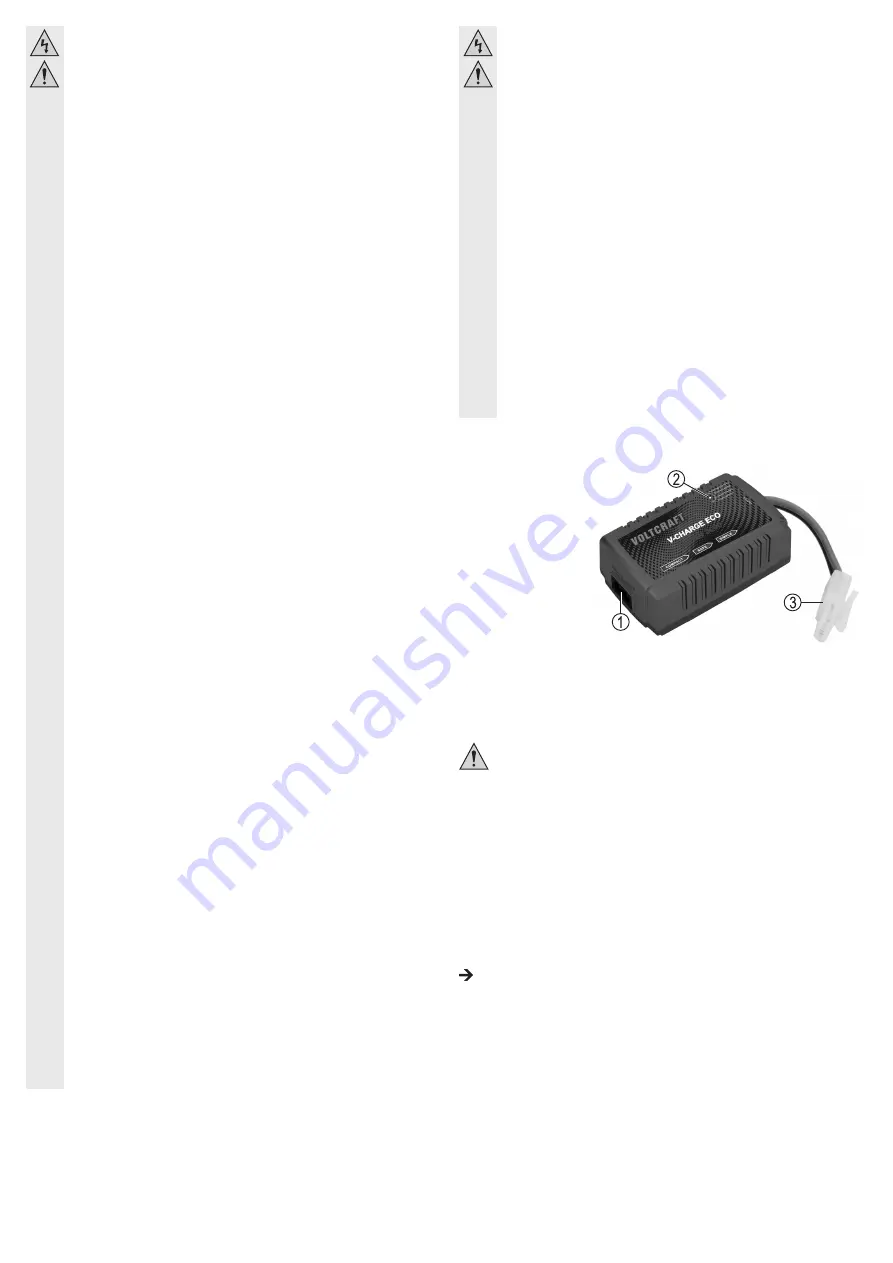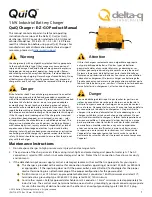
• When used incorrectly (i.e. through an excessive charging current or incorrect
polarity), the rechargeable battery can be overcharged or destroyed. In the worst
case, the rechargeable battery can explode and thereby cause serious damage.
• Never damage the battery, never let the battery fall, do not pierce the battery with
any objects! Avoid applying any mechanical loads to the battery, never pull on the
battery’s connector cables! There is a risk of fire and explosion!
These guidelines must also be observed when the battery is inserted into the
model (if the model is removed, for example).
• Ensure that the battery does not overheat during usage, recharging, discharging,
transport or storage. Do not place the battery adjacent to sources of heat (e.g.
cruise control, motor), keep the battery away from direct sunlight. There is a risk
of fire and explosion if the battery overheats!
• The battery must not reach a temperature higher than +60 °C (observe additional
instructions of the manufacturer with other limitations as applicable!).
• If there are damages on the battery, do not use it any more. Do not recharge it.
There is a risk of fire and explosion!
Only touch the battery with care, use suitable protective gloves.
Dispose of the battery in an environmentally compatible manner.
• When there is no information available from the battery manufacturer about the
maximum permitted charging current, charge the NiCd/NiMH battery with a charg-
ing current of max. 1C. This means that the charging current may not exceed the
capacity value imprinted on the battery (e.g. battery capacity 3000 mAh, max.
charging current 3000 mA = 3 A).
• Observe the additional safety instructions from the manufacturer of the batteries/
battery packs that you use.
CONNECTIONS AND CONTROL ELEMENTS
1 Power socket
2 LED indicator
3 Plug of the charging cable
PUTTING INTO OPERATION AND OPERATION
• Connect the power socket (1) to an appropriate mains socket via the supplied power cable.
• Place the charger on a level, flat, stable surface. Protect valuable furniture surfaces by
using a suitable mat to prevent scratches, pressure points or discolourations.
The casing of the charger heats up during operation. Therefore make sure that the
charger is always adequately ventilated; never cover it while in operation.
• Connect the battery that you want to charge with the plug (3) of the charger. Observe the
correct polarity (plus/+ = red cable, minus/- = black cable).
• The charging process starts immediately after the battery is connected.
A LED (2) indicates the function of the charger:
LED lights up red:
The charging process is under way
LED lights up green:
The charging process is finished
LED flashes red:
No battery is connected
LED flashes green:
The Delta-U voltage detector has detected a full battery. The
charger changes to the float charging current mode
LED flashes red/green: An error is indicated (for e.g. wrong polarity for the battery, cell
voltage too high or too low, etc.)
The max. charging capacity of the charger influences the possible charging current.
Therefore the charging current is lower for an 8-cell battery than for a 2-cell battery.
• When the charging process is done, remove the battery from the charger.
• Then connect another battery for charging or remove the charger from the supply voltage;
pull the power plug out of the mains socket. Keep the product in a dry, cool, dust-free place
that is out of children’s reach.
• Do not operate the product when it is unattended. Although there is a wide range
of comprehensive safety mechanisms on the device, it is impossible to exclude
the possibility of malfunctions or problems occurring while charging a battery.
• When you work with the charger or rechargeable batteries, never wear metallic
or strongly conductive materials, such as jewellery (necklaces, bracelets, rings or
similar objects). A short circuit at the battery or charger poses a danger of fire and
explosion.
• Do not leave the batteries connected to the charger when the charger is not
needed.
Disconnect the charging set from the mains voltage. Pull the mains plug out of the
mains socket. Afterwards, keep the product in a clean, dry, and out of children’s
reach place.
• Use the device in a moderate climate only, do not use it in a tropical climate.
For more information on acceptable environmental conditions, see the chapter
“Technical data”.
• Never use the product immediately after it has been brought from a cold room into
a warm one. The resulting condensation may lead to malfunctions or damage un-
der certain circumstances! Furthermore, this could cause a lethal electric shock!
Allow the charger (and the battery/batteries) to reach room temperature before
connecting the charger to the power supply and using it. This may take several
hours!
• Handle the product with care. The product can be damaged if it is crushed, struck,
under mechanical pressure, vibrated, or dropped, even from a low height.
• If it can be assumed that safe operation is no longer possible, the product must
be turned off and precautions must be taken to ensure that it is not used uninten-
tionally.
It can be assumed that safe operation is no longer possible if the product is visibly
damaged, the product does not work at all, if it was stored long-term in unfavour-
able conditions, or if it was exposed to heavy loads during the transport.
d) Handling rechargeable batteries
• Keep batteries out of the reach of children. Always keep batteries out of the reach
of children.
• Do not leave the batteries lying around in the open; there is a risk of them being
swallowed by children or domestic animals. In such a case, call a doctor immedi-
ately!
• Rechargeable batteries must never be short-circuited, dismantled or thrown into
fire. There is a risk of fire and explosion!
• If your skin comes into contact with leaking or damaged batteries, you may suffer
burns. For this reason you should use suitable protective gloves in this case.
• If any battery connector cables need to be cut to size (e.g. if the battery is sup-
plied without a connector plug), cut each cable individually to prevent a short
circuit occurring. Risk of fire and explosion!
• Only use the charger to charge the batteries with the suitable battery technology
(NiCd or NiMH). Never use this device to charge other types of rechargeable
batteries or non-rechargeable batteries. There is a risk of fire and explosion!
Non-rechargeable batteries are meant to be used once only and must be dis-
posed of when empty. Charge rechargeable batteries intended for that use only.
• Batteries must not get damp or wet.
• Never damage the exterior of a battery. There is a risk of fire and explosion!
• Never charge/discharge rechargeable batteries unsupervised.
• Never charge/discharge a battery directly in the model. First remove the battery
from the model; separate it completely from the speed controller or autopilot.
• Please observe the correct polarity (plus/+ and minus/-) when inserting the
rechargeable battery into the charger or into the model (for e.g. an autopilot).
Should you connect the battery incorrectly, not only will the model be damaged
but also the battery. There is a risk of fire and explosion!
• Do not charge any battery that is still hot (e.g. caused by high charge current from
the model). Allow the battery to cool down to room temperature before attempting
to charge it again.
• Never charge/discharge damaged, leaking or deformed batteries. This can result
in a fire or explosion! Dispose such unusable batteries in an environmentally
compatible manner.
• Never use battery packs that are composed of different types of cells.
• Charge the batteries about every 3 months; otherwise self-discharge can lead to a
so-called deep discharge, which causes the batteries to become unusable.
• Disconnect the battery from the charger when the battery is fully charged.






























